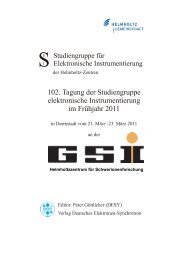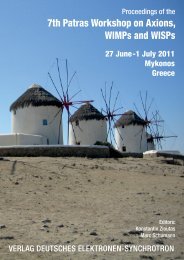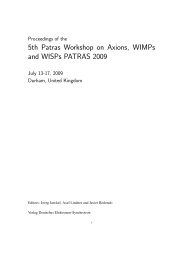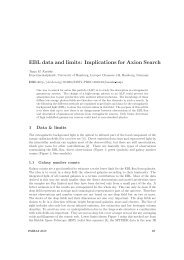Hamburg Neutrinos from Supernova Explosions ... - DESY Library
Hamburg Neutrinos from Supernova Explosions ... - DESY Library
Hamburg Neutrinos from Supernova Explosions ... - DESY Library
Create successful ePaper yourself
Turn your PDF publications into a flip-book with our unique Google optimized e-Paper software.
Luminosity [erg/s]<br />
Mean Energy [MeV]<br />
10 53<br />
10 52<br />
10 51<br />
19<br />
17<br />
15<br />
13<br />
12<br />
11<br />
10<br />
9<br />
8<br />
7<br />
TOBIAS FISCHER, MATTHIAS LIEBENDÖRFER, FRIEDRICH K. THIELEMANN, . . .<br />
νe<br />
νµ,τ , ¯νµ,τ<br />
¯νe<br />
Accretion Deleptonization<br />
0.01 0.1 0.3 1 2 3 5 7 10<br />
¯νµ,τ<br />
νµ,τ<br />
¯νe<br />
νe<br />
0.01 0.1 0.3 1 2 3 5 7 10 20<br />
Time After Bounce [s]<br />
4 Neutrino spectra evolution<br />
Figure 6: Post bounce evolution<br />
of neutrino (dotted lines:<br />
νe, solid lines: ¯νe, dashed<br />
lines: ν µ/τ, dash-dotted lines:<br />
¯ν µ/τ) luminosities (top) and<br />
mean energies (bottom) for<br />
the 18 M⊙ progenitor model<br />
(data are taken form ref. [21]).<br />
At the end of the accretion<br />
phase, indicated by the sharp<br />
jumps at about 350 ms post<br />
bounce, the luminosities of all<br />
flavors decrease continuously.<br />
The same holds for the mean<br />
energies. Furthermore, neutrino<br />
luminosities and spectra become<br />
increasingly similar for all flavors<br />
during the deleptonization<br />
phase. They converge for this<br />
model at about 20 seconds post<br />
bounce. It is related to the<br />
reducing dominance of chargedcurrent<br />
reactions during the<br />
proto-neutron star deleptonization.<br />
Instead, the spectra are<br />
dominated by neutral-current<br />
reactions (neutrino-neutron<br />
scattering).<br />
The evolution of neutrino luminosities and mean energies is shown in Fig. 6 at the example<br />
of the 18 M⊙ progenitor up to 22 seconds post bounce. The observables are sampled in the<br />
co-moving reference frame at a distance of 500 km, well outside the neutrinospheres.<br />
The νe-luminosity, O(10 52 ) erg/s, rises slowly after the deleptonization burst has been<br />
launched at 20 ms post bounce. ¯νe and ν µ/τ are produced only after bounce. The ν µ/τluminosities<br />
rises until about 20 ms post bounce and the ¯νe-luminosity rises continuously. After<br />
reaching their maximum, the ν µ/τ-luminosity decreases slowly continued during the accretion<br />
phase on timescales of 100 ms. Furthermore, the νe and ¯νe luminosities are determined by mass<br />
accretion at the neutrinospheres. They rise slowly on a timescale of 100 ms and reach their<br />
maximum of several 10 52 erg/s at the onset of explosion at about 350 ms post bounce. After<br />
42 HAνSE 2011<br />
7








